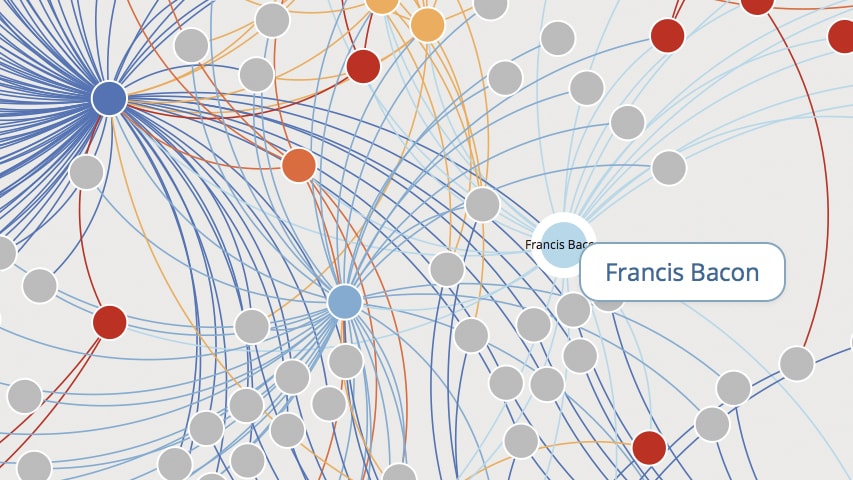Six Degrees of Francis Bacon Launches
Digital Humanities Project Allows Exploration of Early Modern Social Network
By Shilo Rea / 412-268-6094 / shilo@cmu.edu
In today’s digital world, personal connections and even chance encounters are easily documented. Social media “likes” and followers provide insight into who knows whom and who can be potentially exposed to certain news and information. But before Twitter, Facebook, check-ins and shares, it was not so simple to map how people were talking to one another, forming social groups and sharing beliefs and ideas.
For the early modern period, Six Degrees of Francis Bacon changes all of that.
Carnegie Mellon University and Georgetown University have created “Six Degrees of Francis Bacon,” a groundbreaking digital humanities project that recreates the British early modern social network to trace the personal relationships among figures like Bacon, Shakespeare, Isaac Newton and many others. The website lets academics, students and anyone else interested in this period view and add to the network. The site currently identifies more than 13,000 individuals and highlights approximately 200,000 relationships.
“Are you researching Anne Boleyn to find out if she knew Thomas More, author of ‘Utopia?’ Now, you can see that in an instant,” said project director Christopher Warren, associate professor of English in CMU’s Dietrich College of Humanities and Social Sciences. “But not only that, you can see all of the people they knew, thus giving you new ways to consider communities, factions, influences and sources. It’s critical for scholars because even experts have a hard time keeping so many relations in their heads. Meanwhile, newcomers have nearly instantaneous access to contextual information that’s often really difficult to access.”
To create Six Degrees of Francis Bacon, Warren, Georgetown’s Daniel Shore and CMU’s Jessica Otis mined the 62 million words in the Oxford Dictionary of National Biography to map who knew whom between 1500-1700. They relied on CMU’s Department of Statistics and specifically the data mining expertise of Associate Professor Cosma Shalizi and Ph.D. student Lawrence Wang to develop the visual social network. The site was constructed to allow users to add research and knowledge.
“One of the biggest challenges of getting the site to this latest version was building the underlying infrastructure to support the crowdsourcing aspect of the website,” said Otis, a postdoctoral fellow in the English Department. “We have an incredibly rich and complex dataset, and wanted to create a website that would allow experts to contribute their own knowledge to that data. The site has the most vital of these features in place, but we also have several new and exciting features already in development.”
In order to make Six Degrees of Francis Bacon as accessible and accurate as possible, a huge amount of attention was spent on the site’s functionality, design and color schemes.
“Something as basic as color choice on this version of the site represents a lot of thought about how to communicate that scholars probably haven’t studied someone enough,” Warren said. “People whose nodes appear in red have the fewest connections. In most cases, this isn’t because they were solitary people or something like that. Instead, it’s because they’ve generally been underserved in the history of scholarship. Many women, for instance, appear in red. We need to know a lot more about their networks, and the color red helps people see that very quickly.”
Six Degrees of Francis Bacon is an example of how digital humanists can use computers and technology to answer long-sought-after questions and explore fields like literature and history in new ways. It is unique because it encourages professional researchers, students and amateurs to participate in the same community. And, at a basic level, it can give anyone an immediate sense of historical networks and communities and help them develop more sophisticated interpretations.
“For instance, we’ve long known that John Milton didn’t just associate with other poets. Six Degrees of Francis Bacon makes it really easy to see how he was connected to various other spheres of society,” said Shore, associate professor of English at Georgetown. “With a few clicks of a mouse, you can discover that Milton was connected to composers, musicians and cavalier poets through the singer and composer Henry Lawes. His polemical opponent Joseph Hall, the Bishop of Norwich, was his bridge to a sizeable slice of elite English clergy.”
Shore continued, “He was connected to Quakers and other radical religious groups largely through the religious controversialist Thomas Ellwood and the regicide Isaac Pennington. And he was linked to the world of early modern science through Henry Oldenburg, the secretary of the Royal Society, as well as the educational reformer Samuel Hartlib.”
Six Degrees of Francis Bacon has already been used in classrooms at Carnegie Mellon and Georgetown in various ways. Students used the network to understand how early modern people were related, and they also added information to the network based on their own research in the period. The team hopes that more classes take advantage of the tools and information the site offers.
“Six Degrees of Francis Bacon is, perhaps surprisingly, an excellent way to get students to pay close attention to texts,” Shore said. “Every early modern document is a record of complex relations between authors, printers, publishers, booksellers, dedicatees, polemical opponents, and so on. Students can often add to the social network just by studying the relations documented in the title page and front matter of a single 16th-century book.”
The Six Degrees of Francis Bacon project began two years ago with initial funding from a CMU Falk Fellowship, a Google Faculty Research Award and a CMU Wimmer Fellowship. The project also has received recent support from the Council for Libraries and Information Resources/Digital Library Foundation.
View the re-created early modern social network at www.sixdegreesoffrancisbacon.com.
Related Links:
Video: What is Six Degrees of Francis Bacon?